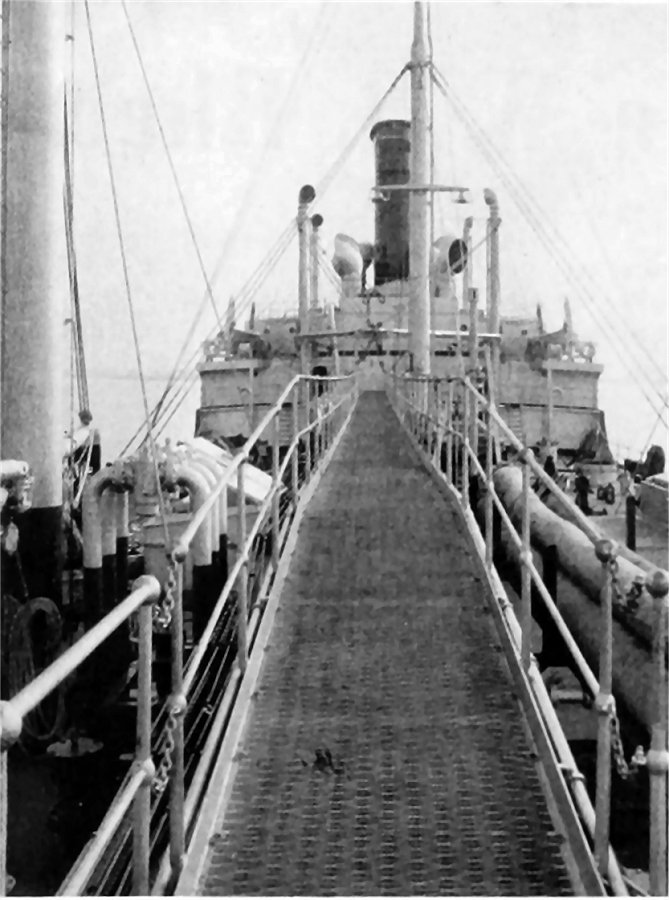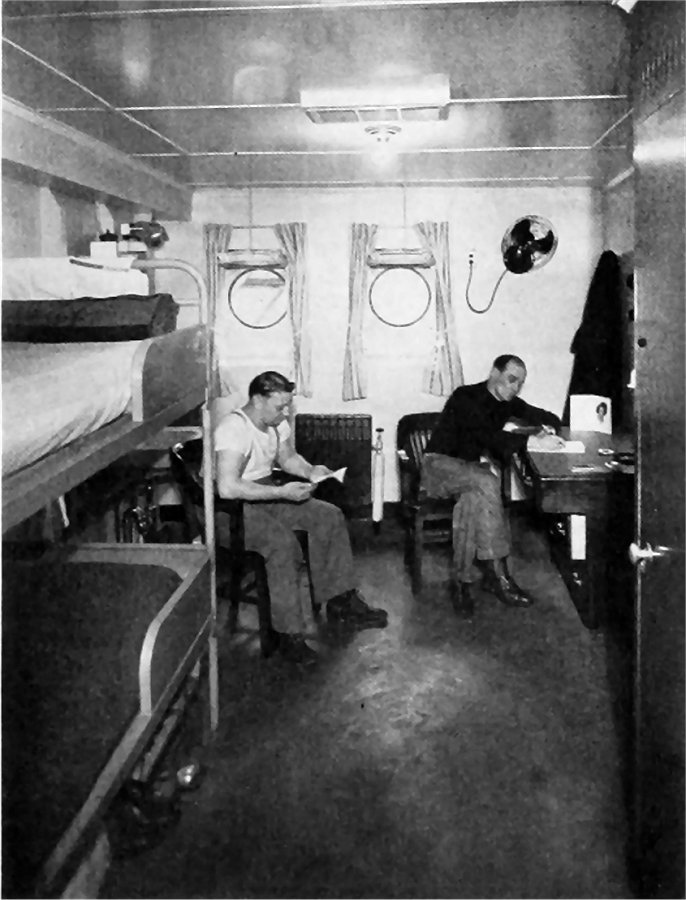Auke Visser's Famous T - Tankers Pages | home
OIL TRANSPORTATION BY TANKER - Part 1 ( by J.J. Coney )
Source : Pacific Marin Review, Volume 42, 1945.
Oil Transportation by tanker ( By J.J. Coyle )
History
THE FIRST transportation of oil on ships was in wooden barrels.
This method was followed by case shipments, which showed considerable improvement inasmuch as cases packed closer than barrels, resulting in lower freight costs. However, both of these methods had the disadvantage of leaks, with consequent loss of oil and claims for shortage, as well as the generation of dangerous gas in the hold of the vessel, requiring only a spark to set it oif.
Further study of the situation led to the idea that the vessel itself should be fitted with iron tanks, into and out of which the oil could be pumped. This system showed considerable economy over the old barrel and case methods, due to quicker loading and discharging, but the leakage of the oil, although less, was not eliminated, and still generated a dangerous gas which filled the spaces between and beneath the tanks and the hull of the ship. Repairs could not be made - electric lights had not been introduced - and hot rivets could not be driven until the gas in the hold of the vessel had been eliminated, incurring great delay and considerable expense.
The next development brought the modern tank vessel, credit for which must be given to the late Wilhelm Riedemann of Hamburg, who conceived the idea of carrying oil in bulk to the skin of the ship. In 1880 he bought a large sailing vessel, the Andromeda, which had been built originally in 1864, during the Civil War, as a warship for the Northern States.
Before completion of the vessel the war came to an end and it was sold to an English firm, but lay idle for a long time.
 For safe passage over the low freeboard decks on modern tankers are fitted with these "Catwalks".
Upon being purchased by Mr. Riedemann he put it to various uses, among others, the importation of petroleum. The vessel had a large cylindrical water tank which went through the various decks, practically from the bottom of the vessel to the upper deck. Since it was no longer used as a water tank, Mr. Riedemann thought of filling it with oil, which practically started the idea of a tank
vessel. When the Andromeda returned from a trip around the world in 1883-85 it was put into a shipyard at Germany and fitted with 40 steel tanks connected together by pipelines.
This enabled the vessel to carry about 2700 tons. Before the installation of the tanks she was able to carry 12,000 barrels of oil, while the capacity after the tanks were installed was 17,000 barrels, showing a gain of about 42 per cent in carrying capacity.
In August, 1885, the work was completed and the vessel sailed on her first trip, the result of which was so highly satisfactory that Mr. Riedemann immediately conceived the idea of building a steamer for the exclusive purpose of carrying petroleum in bulk. No shipyard in his own country would take up the crazy idea, and discussions with shiphuilders, in practically every instance, resulted
in an attempt on their part to dissuade him. However, he finally got an English firm on the Tyne to undertake the same and the result
was the construction of a tank steamer of 3400 tons carrying capacity,, which was completed in 1886. This
vessel, the Gluckauf, was 300 feet long and carried approximately 25,000 barrels in bulk. The success of this vessel resulted in the immediate, construction of others, and by 1892 Mr. Riedemann's fleet alone consisted of 12 tank vessels. The original vessel, the Gluckauf, had longitudinal and transverse bulkheads, so can be considered the prototype of the modern tanker.
The first American bulk tanksteamer, the SS Standard, was built in 1888 by John Roach, Chester Pennsylvania, for the Standard Oil Co. The first oil tanker on the Pacific Coast was the George Loomis, built by the Union Iron Works in San Francisco in 1896, for the predecessor company of the Standard Oil Company of California. This was very small ship with a carrying capacity of 6500 barrels.
Development and Design
The first tankers were built with the machinery amidships, and a large number of them were freighters that were converted by having the tanks built into them. It was some time before the machinery was moved aft, wich eliminated the difficulty of keeping the shaft alley tight in the after tanks. All of these ships were built on the transverse system of framing and most of them were fitted with centerline bulkheads and sumner tanks. These summer tanks were located in the upper outboard edges of the main tanks. This arrangement had a twofold purpose: (1) To cut down the surface area of the tank so as not to impair stability with too great a free surface area when rolling in a seaway; and (2) to allow for loading the main tanks completely with heavy oil without sacrificing the reserve buoyancy. The name "summer tank" came about through the fact that these tanks were seldom loaded except when the ships were proceeding at a summer draft.
Shortly before the first world war the longitudinal system of framing was introduced, and this has become the standard for tankships since that time. The modern large tanker has two longitudinal bulkheads without summer tanks and is of welded construction.
The adoption of the welded construction has materially increased the speed with which a tanker can be built, as well as increasing the carrying capacity because of reduced weight of the hull.
Increase in Size and Speed
Tankships have greatly increased in size and speed. The average tankers built during and after the firs world war were of 10,000 tons dwt and 10-knot speed, while today the average tanker is 16,500 tons dwt with a 14 1/2-knot speed. Great ad vances have also been made in the type of machinery used and the over all efficiency of the same. Most of the first tankers used reciprocating engines, then geared turbines, and now turbine electric drive. Some installations have been made of diesel electric and straight diesel drive, hut these latter have not been as popular with the American shipowners, except for long offshore runs. However, the straight diesel drive has found much favor with foreign tankship owners, especially the Scandinavians, as practically all their ships are driven by this type of machinery.
The overall efficiencies of the propelling machinery have been increased so that practically half as much fuel oil per hp. hour is now
used as was used on the vessels built during and shortly after World War I.
 Crew's Quarters on modern oil tankers are the acme of sea comfort.
Operations of a Tanker
One of the greatest costs in tanker operations is the rapid wasting of hull structure, due to certain products carried. Many attempts have been made to minimise this by the use of coatings of every kind and description - by filling tanks with inert gas to displace oxygen; by cleaning the tanks immediately after cargo has been removed; and by spraying molten metal on with metal spray guns.
All of these attempts so far have proved either ineffective or too costly.
One small ship built recently was lined entirely with sheet nickel and, although this successfully combated the erosive effects of the cargoes, the additional weight and cost could not be justified. As a consequence, in the design of a tankship, all plating and sections of ships are made considerably heavier than strength requirements alone would necessitate, so that the ship will still have sufficient strength to carry on when a considerable portion of its structure has wasted. There is room for improvement along this line in the tankship of the future, and there is now a proposition on foot to make tankship plates with a mild steel core and fuse in thin nickel bearing metal sheets while the plate is being rolled in the mill, making, in effect, a laminated plate or sandwich with mild steel
core and stainless steel surfaces.
However, it would seem to me that the solution would be the development of a rust-resisting steel that was of the same material throughout, and that would have higher tensile strength than the ordinary steel with the cost of manufacture not being too much above that of the present steel.
The operations of a tankship require the carriage of a great number of different commodities, or grades of petroleum products, oftentimes on the same ship. It is necessary, therefore, that the crew be very conversant with the miles of pipeline and the hundreds of valves that are installed throughout the ship and the pumproom, so that there shall be no commingling of the various commodities in the handling of the cargo.
And, as these various products have a considerable variation in weight, it is necessary when carrying a cargo of assorted products to plan the loading of the ship very carefully, both for trim and to minimise any chances of commingling. Incidentally, one of the interesting things about loading a tanker is the fact that oil is loaded into the ship "hot" and, although it is the rule that no cargo shall be accepted at a higher temperature than 125 degrees Fahrenheit, sometimes this temperature is considerably exceeded. It might be interesting to note that a 500-foot ship expands from 12 to 14 inches m length before and after loading cargo, due to increase in
temperature alone.
|